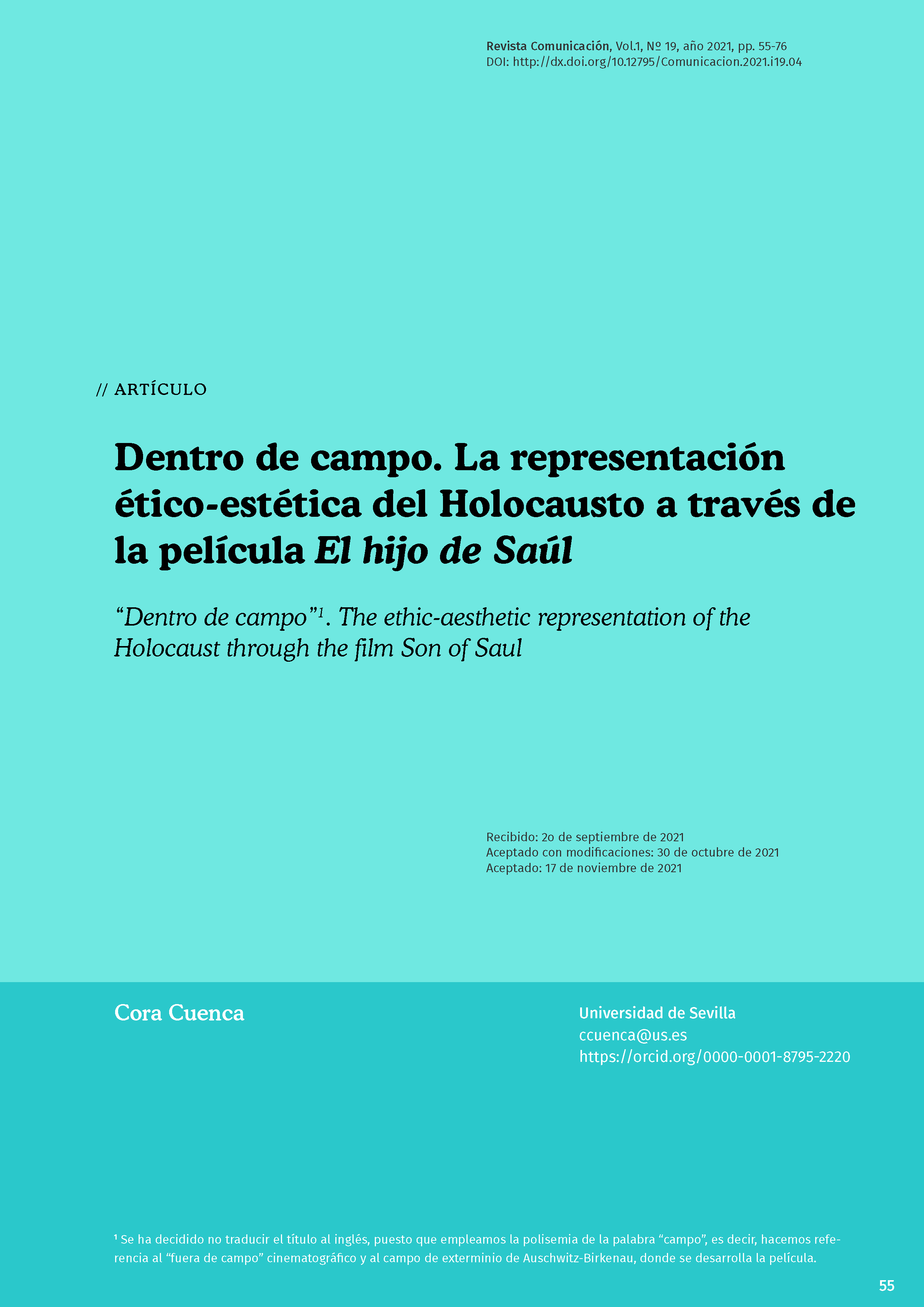Abstract
This paper addresses the audiovisual representation of one of the darkest chapters in the history of humanity: The Holocaust. Starting from Wittgenstein’s proposition that “ethics and aesthetics are one”, we developed a hermeneutic and semiotic analysis of the film Son of Saul (Saul fia, László Nemes, 2015) and dealt with various elements like its editing, image, focus, sound, and color. The goal of this study is to claim the importance of this film as a cultural object that gathers a series of aesthetic decisions that place it ethically in the world and in the cinematographic scene, compared to others that aestheticize, trivialize or monetize the Jewish extermination. Thus, we have reached three conclusions. First of all, that in this continuous wondering about the possibilities of cinema and the aesthetics limits of representation lies the ethical behavior of filmmakers. Second, that the audience shall have to accept the challenge of facing a cinema far beyond the institutional mode of representation (IMR) and become an active part in the exchange of information. Finally, that cinema as a vehicle for social change must serve to the strengthening of democracy and contribute to guarantee the no-repetition of a disaster such as the Holocaust.
References
Blottière, Mathilde (2015). Claude Lanzmann: “‘Le Fils de Saul’ est l’anti- ‘Liste de Schindler’”. Télérama, 25 de mayo. Recuperado de https://www.telerama.fr/festival-de-cannes/2015/claude-lanzmann-le-fils-de-saul-est-l-anti-liste-de-schindler,127045.php
Blumenfeld, Samuel (2007). Rétrocontroverse: 1994, peut-on represénter la Shoah à l’écran? LeMonde, 8 de agosto. Recuperado de https://www.lemonde.fr/idees/article/2007/08/08/retrocontroverse-1994-peut-on-representer-la-shoah-a-lecran_942872_3232.html
Brecht, Bertolt (1998). Más de cien poemas. Madrid: Hiperión.
Breschand, Jean (2004). El documental: la otra cara del cine. Barcelona: Paidós.
Burucúa, José Emilio y Kwiatkowski, Nicolás (2015). “Cómo sucedieron estas cosas”. Representar masacres y genocidios. Madrid: Katz Editores.
Carmona, Carla (2011). El genio: ética y estética son una. En M. J. Alcaraz, M. Carrasco y S. Rubio (Ed.), Art, Emotion and Value. Proceedings of the 5th Mediterranean Congress of Aesthetics (pp. 211-222). Cartagena (España). Recuperado de https://www.um.es/vmca/proceedings/docs/VMCA-Proceedings.pdf
Crespo, Alfonso (2008). Un cine febril. Herzog y El enigma de Kaspar Hauser. Sevilla:
Metropolisiana.
Didi-Huberman, Georges ([2002] 2018). La imagen superviviente. Madrid: Abada Editores.
Didi-Huberman, Georges (2004). Imágenes pese a todo. Barcelona: Paidós.
Didi-Huberman, Georges (2008). Cuando las imágenes toman posición. Madrid: Antonio Machado Libros.
Didi-Huberman, Georges (2015). Sortir du noir. Paris: Les éditions de minuit.
Erdély, Matyas (2015). En ARRI Channel [ARRIChannel] (27 de noviembre de 2015). ARRI Interview: Mátyás Erdély about “Son of Saul” [Archivo de vídeo]. YouTube. https://www.youtube.com/watch?v=kTBKZUHsFbk&t=379s
Ferrando García, Pablo, y Gómez Tarín, Francisco Javier (2018). La inmersión subjetiva de un relato fenomenológico. A propósito de El hijo de Saúl (Saul fia, Lászlo Nemes, 2015). Fotocinema, 17, p. 297-320.
Ginzburg, Carlo ([1976] 2001). El queso y los gusanos. Barcelona: Muchnik Editores.
Godard, Jean-Luc (2007). Historia(s) del cine. Buenos Aires: Caja Negra.
Goethe, Johann Wolfgang ([1810] 2015). Theory of colours. Londres: John Murray. Recuperado de http://www.gutenberg.org/files/50572/50572-h/50572-h.htm
Gradowski, Zalmen (1988). The Czech Transport: A Chronicle of the Auschwitz Sonderkommando. En D. Roskies (Ed.), The Literature of Destruction: Jewish Responses to Catastrophe (pp. 548-564). Harvard: Harvard University Press.
Kertész, Imre (1999). ¿A quién pertenece Auschwitz? Un superviviente del holocausto ante la película ‘La vida es bella’. Lateral: Revista de Cultura, 57, 14-15.
Kertész, Imre (2004). Diario de la galera. Barcelona: Acantilado.
Lanzmann, Claude ([1985] 2003). Shoah. Madrid: Arena.
Margitházi, Beja (2020). Embodying sense memory: archive image and traumatic experience in Son of Saul, Warsaw Uprising and Regina. Studies in Eastern European Cinema, 11(1), 82-100.
Martínez, Luis (2016). ‘El hijo de Saúl’: Miedo a mirar. El Mundo, 15 de enero.
Mate, Reyes (2003). Memoria de Auschwitz. Madrid: Trotta
Mayorga, Juan (2016). Elipses. Segovia : La Uña Rota.
Nemes, László (2015). En Alda, R. [6 de abril de 2019]. El cine de la 2 – El hijo de Saúl
(presentación) [Archivo de vídeo]. RTVE.es. https://www.rtve.es/alacarta/videos/el-cine-dela-2/cine-2-hijo-saul-presentacion/5124261
Nemes, László y Royer, Clara (2014). Son of Saul (guion). Recuperado de https://thescriptsavant.com/pdf/TheSonOfSaul.pdf
O’Sullivan, Michael (2016). ‘Son of Saul’: an inmersive portrait of life in a Nazi death camp. The Washington Post, 15 de enero. Recuperado de: https://www.washingtonpost.com/lifestyle/style/in-son-of-saul-an-immersive-portrait-of-life-in-a-nazi-deathcamp/2016/01/14/191e3c6e-b946-11e5-99f3-184bc379b12d_story.html
Pena, Jaime (2020). El cine después de Auschwitz. Madrid: Cátedra.
Rancière, Jacques. (2001). S’il y a de l’irreprésentable. Le genre humain, 36, 81-102.
Ridao, José María (2010). “Vivimos en un mundo que no sabe a dónde va”. El País, 18 de enero. Recuperado de: https://elpais.com/diario/2010/01/18/cultura/1263769201_850215.html
Rodríguez-Serrano, Aarón (2015). Espejos en Auschwitz. Apuntes sobre cine y Holocausto. Santander: Shangrila.
Sánchez-Biosca, Vicente (1991). Teoría del montaje cinematográfico. Valencia: Filmoteca de la Generalitat Valenciana.
Sánchez-Biosca, Vicente (1999). Hier ist kein warum. A propósito de la memoria y la imagen de los campos de la muerte. En A. Lozano (Ed.), La memoria de los campos. El cine y los campos de concentración nazis (pp. 13-38). Valencia: Ediciones de la Mirada.
Sánchez-Biosca, Vicente (2006). Cine de historia, cine de memoria. Madrid: Cátedra.
Sardá, Juan (2012). Costa-Gavras: «Todo el cine es político». El Cultural, 30 de noviembre. Recuperado de: https://elcultural.com/Costa-Gavras-Todo-el-cine-es-politico
Semprún, Jorge (2000). L’art contre l’oublie. Le monde des débats, mayo, 11-13.
Unamuno, Miguel ([1913] 1976). Del sentimiento trágico de la vida. Madrid: Espasa-Calpe.
Van Alphen, Ernst (1998). Caught by History: Holocaust Effects in Contemporary Art, Literature, and Theory. Stanford: Stanford University Press.
Wittgenstein, Ludwig ([1921] 1961). Tractatus Logico-Philosophicus. Madrid: Alianza.
Wittgenstein, Ludwig (1992). Lecciones y conversaciones sobre estética, psicología y creencia religiosa. Barcelona: Paidós.
Zizek, Slavoj (2009). Description without a place. On Holocaust and Art. Inaesthetik: Politics of Art, 1,142-161.

This work is licensed under a Creative Commons Attribution-NonCommercial-ShareAlike 4.0 International License.
Copyright (c) 2021 Cora Cuenca

